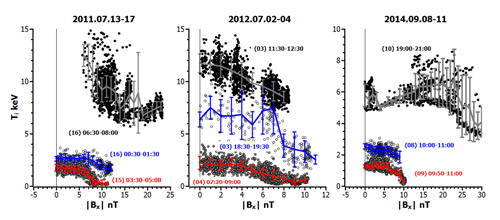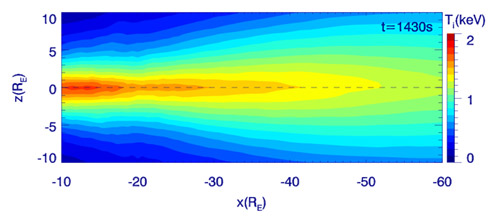
2017 THEMIS SCIENCE NUGGETS
The ion temperature gradient: An intrinsic property of Earth’s magnetotail
by San Lu
UCLA EPSS/IGPP
Introduction
Spacecraft observations have revealed that ion temperature in the Earth's magnetotail is nonuniform in both the Earth-tail (in the GSM x direction, along the magnetotail) and north-south (in the GSM z direction, across the magnetotail) directions. The ion temperature has been found to increase in the earthward direction, i.e., higher in the near-Earth regions. The earthward ion temperature gradient balances magnetic tension forces caused by the magnetotail magnetic field configuration. The ion temperature gradient also exists in the north-south direction, which is shown by a bell-shaped ion temperature Ti profile versus Bx (Bx is a proxy of distance from the neutral sheet). To better understand the observed temperature profiles in the magnetotail, a key question needs to be addressed: What is the relationship between the x gradient and the z gradient of ion temperature? Global hybrid simulation, being able to describe (1) ion convection motion in a global scale from the lunar distance to the near-Earth plasma sheet edge and (2) small-scale ion kinetics (important to resolve ion isotropization caused by scattering within the magnetotail current sheet), is used in this study to reveal the mechanism responsible for the temperature gradient.
| Figure 1. Ion temperature Ti(keV) versus magnetic field |Bx |(nT), black and grey circles indicate measured data, and colored curves with errors show averaged data: THEMIS D at x≈-10RE (grey curve, filled black circles), Geotail at x≈-25RE (blue curve, empty black circles), and ARTEMIS P1 at x≈-55RE (red curve, filled grey circles). For each averaged profile, we show day (in brackets) and time interval of measurements. |
Results
THEMIS, Geotail, and ARTEMIS spacecraft simultaneously observe the magnetotail at different geocentric distances. Figure 1 shows three events of THEMIS D, Geotail, and ARTEMIS P1 conjunct observations of Ti (Bx ) at different distances from the Earth. THEMIS D crossed the current sheet at x≈-10RE; Geotail crossed the current sheet at x≈-25RE; and ARTEMIS P1 crossed the current sheet around lunar orbit x≈-55RE. The temperature profiles are similar in the three geocentric distances: higher at the current sheet center and decrease towards the current sheet upper and lower boundaries. The ion temperature is also higher in the near-Earth (observed by THEMIS D) and decreases towards the downtail. The multispacecraft observations show that the ion temperature gradient is a universal intrinsic property of the Earth’s magnetotail.
| Figure 2. Global hybrid simulation (ANGIE3D) result of ion temperature distribution in the x-z plane of the magnetotail averaged over -10R_E≤y≤10R_E at a representative time, t=1430s. |
A three-dimensional global hybrid simulation using ANGIE3D (AuburN Global hybrId codE in 3-D) is performed to investigate how the temperature gradient is formed. Figure 2 shows the simulation result, the ion temperature distribution in the x-z plane. The simulation well reproduces the observed ion temperature profile: higher at the current sheet center and decreases towards current sheet boundary (in the z direction) and downtail (in the x direction). By showing the absence of field-aligned gradient of ion temperature, we demonstrate that the mapping of the x gradient of ion temperature along magnetic field lines processes the bell-shaped Ti (Bx ) profiles.
Conclusion
Using simultaneous THEMIS D, Geotail, and ARTEMIS P1 observations, we show that the Ti (Bx ) profiles are ubiquitously bell-shaped in the magnetotail. We use 3-D global hybrid simulations to describe how the profiles are formed. According to the simulation results, in the absence of a field-aligned gradient of the ion temperature, the Ti (x) profile is mapped along magnetic field lines and forms the bell-shaped Ti (Bx ) profile in the z direction.
Reference
Lu, S., A. V. Artemyev, V. Angelopoulos, Y. Lin, and X. Y. Wang (2017), The ion temperature gradient: An intrinsic property of Earth’s magnetotail, J. Geophys. Res. Space Physics, 122, doi:10.1002/2017JA024209.Biographical Note
San Lu is an Assistant Researcher in space physics at the University of California, Los Angeles. His primary research interests are computer simulations (particle-in-cell and hybrid) of space and laboratory plasma physics.
 Please send comments/suggestions to
Emmanuel Masongsong / emasongsong @ igpp.ucla.edu
Please send comments/suggestions to
Emmanuel Masongsong / emasongsong @ igpp.ucla.edu


